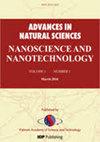探索利用快速电子反向散射测定 C/O 比率:氧化石墨烯和还原氧化石墨烯的可能应用
IF 2.1
Q3 MATERIALS SCIENCE, MULTIDISCIPLINARY
Advances in Natural Sciences: Nanoscience and Nanotechnology
Pub Date : 2024-08-28
DOI:10.1088/2043-6262/ad6cc1
引用次数: 0
摘要
GO 和 rGO 是一种应用广泛的碳纳米结构。碳氧比(C/O)是决定其许多基本特性的基本参数。这些材料的大规模生产需要使用快速、有代表性的方法来确定碳氧比。在本研究中,我们探讨了使用快速电子反向散射法测定这一关系的可行性。该方法快速且无需事先处理样品,在 C/O ∼ 10-35 的情况下,准确度约为 11%-15%,精度约为 0.4%。据估计,检测到的反向散射电子来自质量为 0.04-0.4 克的样品,具体取决于所使用的合成方法。背向散射法的精确度与 EDX 和 XPS 大致相当,但在精确度和代表性方面却超过了它们。与上述技术相比,背散射设备更为经济,但它会受到杂质的影响。因此,我们认为背散射是大规模控制特定技术生产的 GO 和 rGO 样品并通过严格的元素分析进行校准的合适方法。本文章由计算机程序翻译,如有差异,请以英文原文为准。
Exploring the use of fast electron backscattering for the determination of the C/O ratios: possible applications to graphene oxide and reduced graphene oxide
GO and rGO are carbon nanostructures with a wide range of applications. The carbon/oxygen ratio (C/O) is a basic parameter that determines many of its essential properties. The large-scale production of these materials requires the use of fast and representative methods to determine the C/O ratio. In the present work, the feasibility of using fast electron backscattering to determine this relationship was explored. The method is rapid and does not require previous sample treatment, its accuracy is approximately 11%–15% for C/O ∼ 10–35 and its precision is around 0.4%. It was estimated that the backscattered electrons being detected came from a sample mass of 0.04–0.4 g, depending on the synthesis method used. The accuracy of the backscatter method is approximately equal to that of EDX and XPS, but it surpasses them in precision and representativeness. Backscattering equipments are more economical when compared to the above-mentioned techniques; however, it can be affected by the presence of impurities. Therefore, we consider it an appropriate method for the large-scale control of samples of GO and rGO produced by a given technology and calibrated with a rigorous elemental analysis.
求助全文
通过发布文献求助,成功后即可免费获取论文全文。
去求助
来源期刊

Advances in Natural Sciences: Nanoscience and Nanotechnology
NANOSCIENCE & NANOTECHNOLOGYMATERIALS SCIE-MATERIALS SCIENCE, MULTIDISCIPLINARY
自引率
4.80%
发文量
0
 求助内容:
求助内容: 应助结果提醒方式:
应助结果提醒方式:


